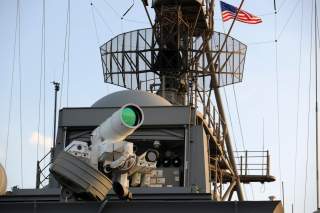Zap Zap: The Navy Will Soon Have Megawatt Laser Cannons on Its Warships
Sci-fi is now real life.
Key point: These lasers will help take out drones and missiles. After a lot of tests, the military hopes for them to become widespread.
The U.S. Navy on Oct. 17, 2019 began shipping a powerful new laser weapon from a Northrop Grumman facility in Redondo Beach, California to a Navy base in San Diego.
This article first appeared in 2019 and is being reposted due to reader interest.
The War Zone was the first to report on the painstaking process of moving the bulky weapon.
In San Diego, workers will install the 150-kilowatt laser on the amphibious assault ship USS Portland. The vessel’s crew plans to test the new weapon beginning this year as part of an accelerating effort by the Navy to install laser cannons on its warships.
Northrop Grumman built the laser under the auspices of the Navy’s $53-million Solid-State Laser Technology Maturation program, which launched in 2015.
As a shipboard weapon, a laser could hold several advantages over traditional weapons such as guns or missiles. For one, a laser does not need ammunition. As long as the ship has power, the laser can continue firing. A laser also could strike targets faster than, say, a missile could do.
But today’s lasers lack the power and range to destroy large targets or do any damage at all at ranges farther than a few miles. SSL-TM and a related effort at Lockheed Martin could result in lasers with the power and range to defend ships from drones, small boats, cruise missiles and even ballistic missiles.
"Low-cost directed-energy weapons have to be part of our future," Adm. William Moran, then Vice Chief of Naval Operations, said at an industry conference in 2016. "If we have to continue to rely on projectiles, we will run out of the ability to defend ourselves."
The Navy intends SSL-TM to be a learning experience, USNI News explained. The service selected Portland to host the weapon because the 25,000-ton-displacement vessel possesses the space and spare electrical power effectively to host Northrop’s tractor-trailer-size laser.
“Once installed on the ship, the Navy will learn much about laser weapons through SSL-TM testing,” USNI News reporter Megan Eckstein wrote.
Though the laser installed on Portland won’t be the final iteration of this project, [Navy technologist Frank] Peterkin said the Navy can start learning more about how the crew would decide when to use the laser weapon versus a kinetic weapon, how the laser and its optics hold up while in close proximity to the vibrations and gases coming from missile launches, and more.
“We don’t want to wait for the next step to learn this stuff that we can learn now,” Peterkin said.
“This won’t change just because we go to a higher power laser. So we can burn down a lot of this operational risk, not just for the interactions and the interface but also being in close proximity to other weapons. And how do you coordinate, how do you decide what to shoot and when, things like that.”
The Navy’s laser experimentation began in 2014, when the service installed an experimental, 30-kilowatt laser aboard the amphibious ship USS Ponce and tested it at short range against flimsy target drones and boats. Defense contractor Kratos quickly cobbled together that initial laser using existing components.
It was unimpressive. The tests "reminded me of an old cartoon in which someone shot an arrow at the side of a barn, then painted a bulls-eye around the spot where the arrow landed," Subrata Ghoshroy, an MIT researcher, wrote for Bulletin of the Atomic Scientists.
Around the same time the Navy tapped Northrop to build the SSL-TM, the sailing branch also awarded Lockheed a $150-million contract to develop the High-Energy Laser with Integrated Optical-Dazzler and Surveillance system, or HELIOS.
The 60-kilowatt HELIOS draws less power than the SSL-TM does. The Navy plans to begin installing the smaller laser cannon on destroyers starting in 2021. The Office of Naval Research’s small Optical Dazzling Interdictor, or ODIN, functions as a proof-of-concept for the more-powerful HELIOS laser.
The Navy hopes to begin fielding a megawatt-class laser in the 2025 timeframe. A laser with that kind of power could destroy ballistic missiles, but might require a very large host ship that also has ample electrical power. A nuclear-powered aircraft carrier, for instance.
David Axe serves as Defense Editor of the National Interest. He is the author of the graphic novels War Fix, War Is Boring and Machete Squad. This article first appeared in 2019 and is being reposted due to reader interest.
Image: Reuters.

